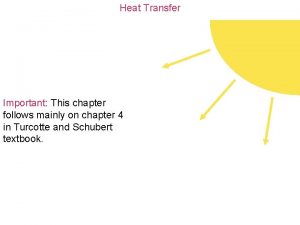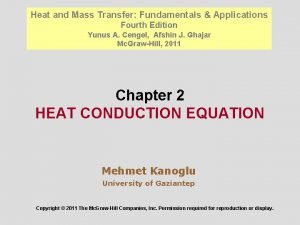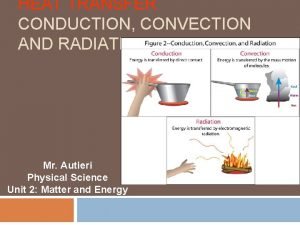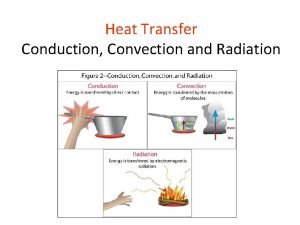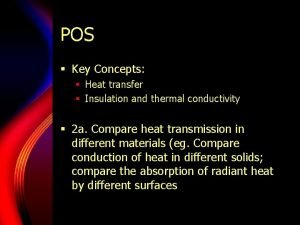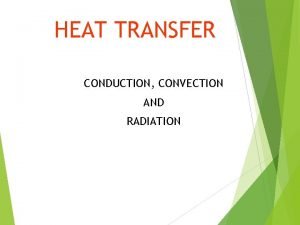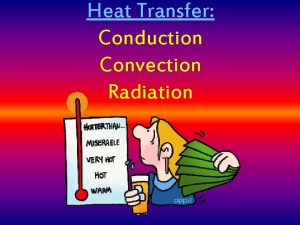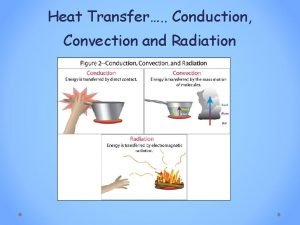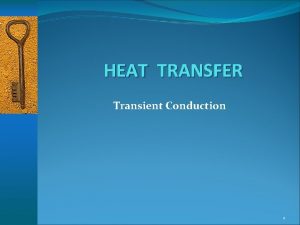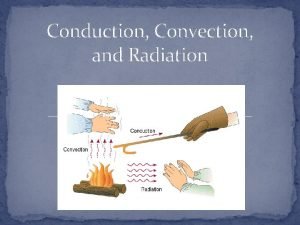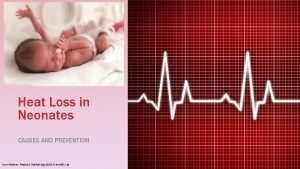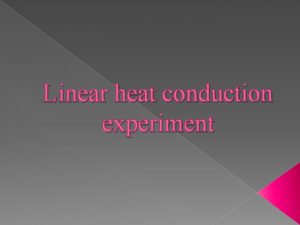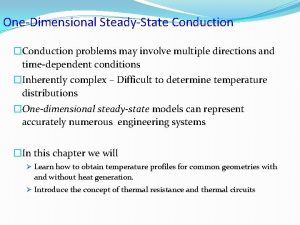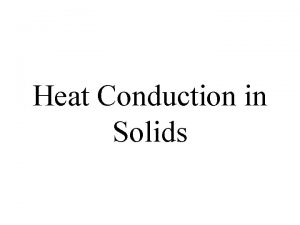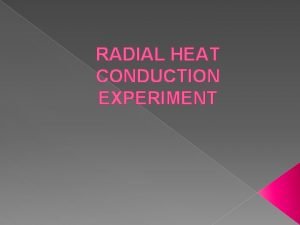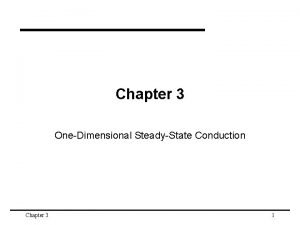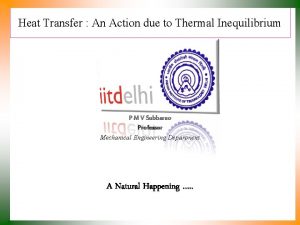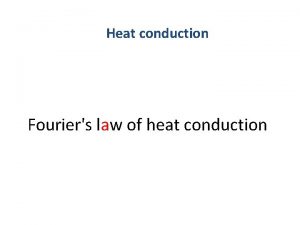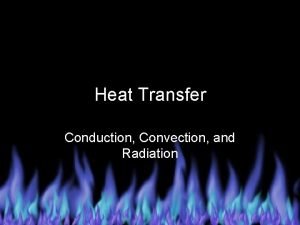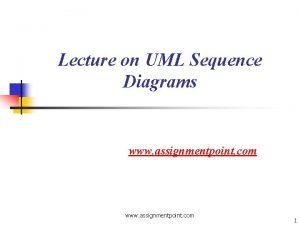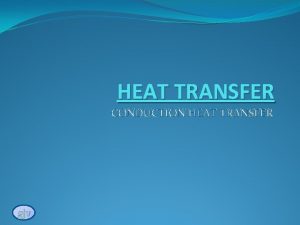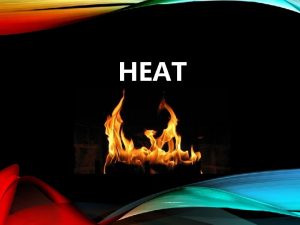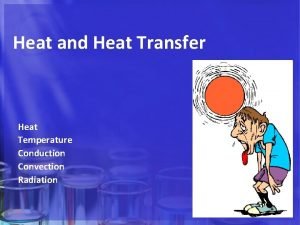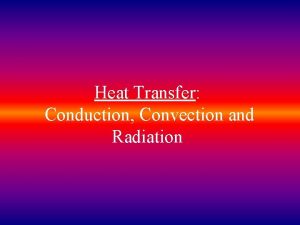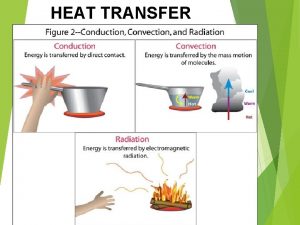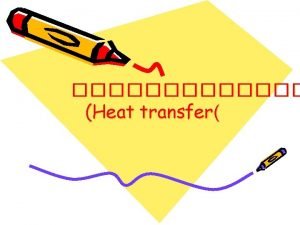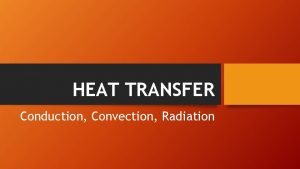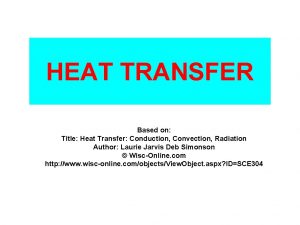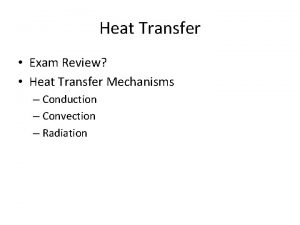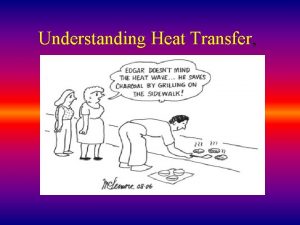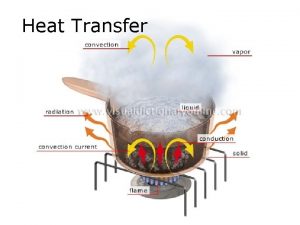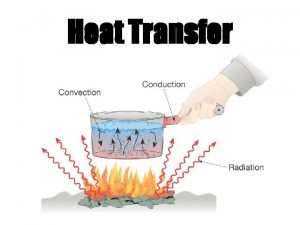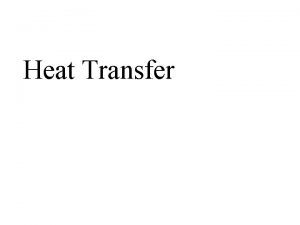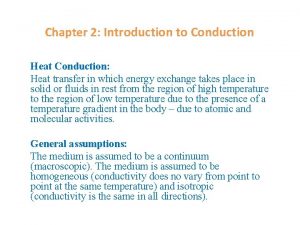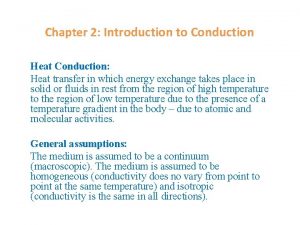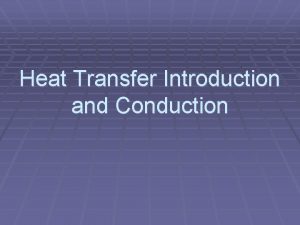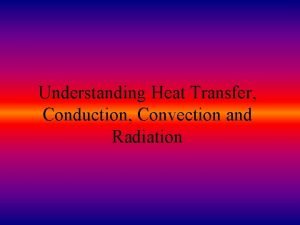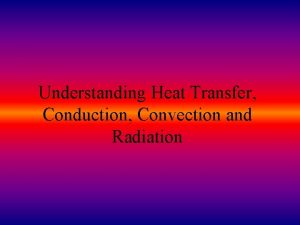Conduction www assignmentpoint com Conduction Transfer of heat




























- Slides: 28

Conduction www. assignmentpoint. com

Conduction • Transfer of heat is through a SOLID by being passed from one particle to the next • Particles at the warm end move faster and this then causes the next particles to move faster and so on. e. g: poker in fire spoon in tea • In this way heat in an object travels from: the HOT end the cold end www. assignmentpoint. com

Conduction • When you heat a metal strip at one end, the heat travels to the other end. • As you heat the metal, the particles vibrate, these vibrations make the adjacent particles vibrate, and so on, the vibrations are passed along the metal and so is the heat. We call this? Conduction www. assignmentpoint. com

Conductors/Insulators • If a substance easily allows heat to move through it, we can say it is a good conductor of heat. e. g: most metals • If a substance does not allow heat to pass through it easily we can say it is an Insulator. E. g: wood, plastic, glass • Why do many sauce pans have plastic handles? www. assignmentpoint. com

Conduction V Insulation www. assignmentpoint. com

Conductor or Insulator? • • Wood? Aluminium? Plastic? Glass? Iron? Polystyrene? Copper? Cardboard? www. assignmentpoint. com

Convection What happens to the particles in a liquid or a gas when you heat them? The particles spread out and become less dense. A liquid or gas. www. assignmentpoint. com

Convection • It is the way in which particles in a GAS or LIQUID move upwards, carrying heat with them • Think about when you boil water, the bubbles move upwards • Or think of a gas heater in the room, the heat rises around the room www. assignmentpoint. com

Convection Cools at the surface Convection current Cooler water sinks Hot water rises www. assignmentpoint. com

Convection Where is the cooling compartment put in a fridge? Cooling compartment It is warmer at the bottom, so this warmer air rises and a convection current is set up. It is put at the top, because cool air sinks, so it cools the food on the way down. www. assignmentpoint. com

Should a radiator be called a radiator? www. assignmentpoint. com

Convection questions Why does hot air rise and cold air sink? Cool air is more dense than warm air, so the cool air ‘falls through’ the warm air. Why are boilers placed beneath hot water tanks in people’s homes? Hot water rises. So when the boiler heats the water, and the hot water rises, the water tank is filled with hot water. www. assignmentpoint. com

Heat Vs Temperature • The temperature of an object tells us how HOT it is • Measured in degrees Celsius - °C • It is NOT the same as heat energy although the two quantities are related. e. g. a beaker of water at 60 °C is hotter than a bath of water at 40 °C BUT the bath contains more joules of heat energy www. assignmentpoint. com

Heating and Cooling • If an object has become hotter, it means that it has gained heat energy. • If an object cools down, it means it has lost energy www. assignmentpoint. com

Heating and Cooling cont… • Heat energy always moves from: • HOT object COOLER object e. g. Cup of water at 20 °C in a room at 30°C gains heat energy and heats up – its temperature rises Cup of water at 20 °C in a room at 10°C loses heat energy and cools down – its temperature will fall. www. assignmentpoint. com

Expansion/Contraction • Why are gaps left in pavements, railway tracks, and floor boards? • Why are electricity cables left slack? • Why are bottles of minerals not filled up to the top? • Because materials expand when they heat up we need to leave room for that. www. assignmentpoint. com

Expansion V Contraction • The reason materials expand when heated is because the heat gives the molecules energy and as a result they begin to move, leaving them further apart and hence the material expands • Cooling has the opposite effect, the particles move closer together causing the molecules to contract • One exception: water expands when www. assignmentpoint. com cooled

Revision 1. Which of the following is not a method of heat transfer? A. Radiation B. Insulation C. Conduction D. Convection www. assignmentpoint. com

Revision 1. Which of the following is not a method of heat transfer? A. Radiation B. Insulation C. Conduction D. Convection www. assignmentpoint. com

2. In which of the following are the particles closest together? A. Solid B. Liquid C. Gas D. Fluid www. assignmentpoint. com

2. In which of the following are the particles closest together? A. Solid B. Liquid C. Gas D. Fluid www. assignmentpoint. com

3. How does heat energy reach the Earth from the Sun? A. Radiation B. Conduction C. Convection D. Insulation www. assignmentpoint. com

3. How does heat energy reach the Earth from the Sun? A. Radiation B. Conduction C. Convection D. Insulation www. assignmentpoint. com

4. Which is the best surface for reflecting heat radiation? A. Shiny white B. Dull white C. Shiny black D. Dull black www. assignmentpoint. com

4. Which is the best surface for reflecting heat radiation? A. Shiny white B. Dull white C. Shiny black D. Dull black www. assignmentpoint. com

5. Which is the best surface for absorbing heat radiation? A. Shiny white B. Dull white C. Shiny black D. Dull black www. assignmentpoint. com

5. Which is the best surface for absorbing heat radiation? A. Shiny white B. Dull white C. Shiny black D. Dull black www. assignmentpoint. com

Key Words Temperature Cold Insulator Radiation Transfer Heat Convection Conduction Emit Conductor www. assignmentpoint. com Absorb
 Cơm
Cơm Bài thơ mẹ đi làm từ sáng sớm
Bài thơ mẹ đi làm từ sáng sớm What is heat transfer conduction convection and radiation
What is heat transfer conduction convection and radiation Transfer heat
Transfer heat Conduction formula
Conduction formula Convection and radiation
Convection and radiation Radiation example
Radiation example Energy transfer
Energy transfer Radiation example
Radiation example How does conduction transfer heat
How does conduction transfer heat Example of conduction heat transfer
Example of conduction heat transfer Heat transfer conduction convection and radiation
Heat transfer conduction convection and radiation Transient conduction heat transfer
Transient conduction heat transfer Heat transfer electrical analogy
Heat transfer electrical analogy Heat energy is transferred by conduction whenever molecules
Heat energy is transferred by conduction whenever molecules Heat conduction expert
Heat conduction expert Evaporation heat loss newborn
Evaporation heat loss newborn Linear heat conduction experiment
Linear heat conduction experiment Critical radius of insulation for cylinder
Critical radius of insulation for cylinder โจทย์ heat transfer พร้อมเฉลย
โจทย์ heat transfer พร้อมเฉลย Radial heat conduction experiment
Radial heat conduction experiment One dimensional steady state heat conduction
One dimensional steady state heat conduction Fourier's law of heat conduction
Fourier's law of heat conduction Radial heat conduction
Radial heat conduction Radial heat conduction
Radial heat conduction Conduction, convection radiation diagram
Conduction, convection radiation diagram Assignmentpoint.com
Assignmentpoint.com Assignmentpoint.com
Assignmentpoint.com Mail @ assignmentpoint.com
Mail @ assignmentpoint.com



